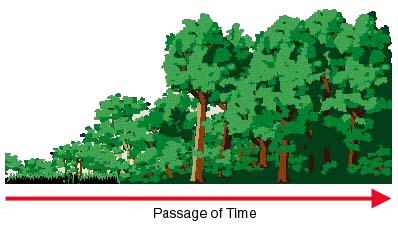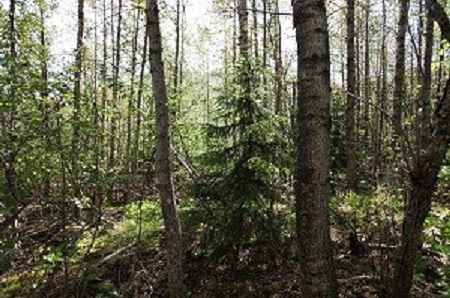Key Concepts
A directional change in an ecological community. Populations of animals and plants are in a dynamic state. Through the continual turnover of individuals, a population may expand or decline depending on the success of its members in survival and reproduction. As a consequence, the species composition of communities typically does not remain static with time. Apart from the regular fluctuations in species abundance related to seasonal changes, a community may develop progressively with time through a recognizable successional sequence (also known as a sere; Fig. 1). Pioneer populations are replaced by successive colonists along a more or less predictable path toward a relatively stable community. This process of succession results from interactions between different species, and between species and their environment, which govern the sequence and the rate with which species replace each other. The rate at which succession proceeds depends on the species' life history as well as on the effects species may have on each other and on the environment which supports them. See also: Ecological community; Population ecology

The course of ecological succession depends on initial environmental conditions. Primary succession occurs on areas such as volcanic ash, glacial deposits, or bare rock. In such harsh, unstable environments, pioneer colonizing organisms must have wide ranges of ecological tolerance to survive. In contrast, secondary succession is initiated by disturbance, such as fire, which removes a previous community from an area. Pioneer species are here constrained not by the physical environment but by their ability to enter and exploit the vacant area rapidly. See also: Fire and disturbance ecology
As succession proceeds, many environmental factors may change through the influence of the community. Especially in primary succession, this leads to more stable, less severe environments. At the same time interactions between species of plant tend to intensify competition for basic resources such as water, light, space, and nutrients. Successional change results from the normal complex interactions between organism and environment which lead to changes in overall species composition. Whether succession is promoted by changing environmental factors or competitive interactions, species composition alters in response to availability of niches. Populations occurring in the community at a point in succession are those able to provide propagules (such as seeds) to invade the area, being sufficiently tolerant of current environmental conditions, and able to withstand competition from members of other populations present at the same stage (Fig. 2). Species lacking these qualities either become locally extinct or are unable to enter and survive in the community.

Primary succession
In some cases, successional sequences may take hundreds of years to complete, and direct observation at a given site is not possible. Adjacent sites may be identified as successively older stages of the same successional sequence, if it is assumed that conditions were similar when each seral stage was initiated.
Climax community
Early stages of succession tend to be relatively rapid, whereas the rates of species turnover and soil changes become slower as the community matures. Eventually an approximation to the steady state is established with a relatively stable community, the nature of which has aroused considerable debate. Earlier, the so-called climax vegetation was believed to be determined ultimately by regional climate and, given sufficient time, any community in a region would attain this universal condition. This unified concept of succession, the monoclimax hypothesis, implies the ability of organisms progressively to modify their environment until it can support the climatic climax community. Although plants and animals do sometimes ameliorate environmental conditions, evidence suggests overwhelmingly that succession has a variety of stable end points. This hypothesis, known as the polyclimax hypothesis, suggests that the end point of a succession depends on a complex of environmental factors that characterize the site, such as parent material, topography, local climate, and human influences.
Autogenic vs. allogenic factors
Actions of the community on the environment, termed autogenic, provide an important driving force promoting successional change, and are typical of primary succession where initial environments are inhospitable. Alternatively, changes in species composition of a community may result from influences external to the community called allogenic.
Whereas intrinsic factors often result in progressive successional changes, that is, changes leading from simple to more complex communities, external (allogenic) forces may induce retrogressive succession, that is, toward a less mature community. For example, if a grassland is severely overgrazed by cattle, the most palatable species will disappear. As grazing continues, the grass cover is reduced, and in the open areas weeds characteristic of initial stages of succession may become established.
Autotrophic vs. heterotrophic succession
In some instances of succession, the food web was based on photosynthetic organisms and there was a slow accumulation of organic matter, both living and dead. This is termed autotrophic succession. In other instances, however, addition of organic matter to an ecosystem initiates a succession of decomposer organisms which invade and degrade it. Such a succession is called heterotrophic. See also: Eutrophication; Productivity; Food web
Secondary succession
Following the partial or complete destruction of an established community by disturbing events, such as fire or the removal of all trees (clearfelling), and similarly on the cessation of grazing or tillage, a sequence of species invasion and replacement ensues. Compared to the slow initial progress of primary succession in which amelioration of the environment plays an important part, secondary succession is characterized initially by rapid turnover of typically opportunist species that invade relatively congenial habitats.
Mechanisms of species replacement
Observed changes in the structure and function of seral communities result from natural selection of individuals within their current environment. Three mechanisms by which species may replace each other have been proposed; the relative importance of each apparently depends on the nature of the successional sequence and stage of development.
1. The facilitation hypothesis states that invasion of later species depends on conditions created by earlier colonists. Earlier species modify the environment so as to increase the competitive ability of species which are then able to displace them. Succession thus proceeds because of the effects of species on their environment.
2. The tolerance hypothesis suggests that later successional species tolerate lower levels of resources than earlier occupants and can invade and replace them by reducing resource levels below those tolerated by earlier occupants. Succession proceeds despite the resistance of earlier colonists.
3. The inhibition hypothesis is that all species resist invasion of competitors and are displaced only by death or by damage from factors other than competition. Succession proceeds toward dominance by longer-lived species.
None of these models of succession is solely applicable in all instances. Indeed, most examples of succession appear to show elements of all three replacement mechanisms.
Deterministic vs. stochastic succession
Succession has traditionally been regarded as following an orderly progression of changes toward a predictable end point, the climax community, in equilibrium with the prevailing environment. This essentially deterministic view implies that succession will always follow the same course from a given starting point and will pass through a recognizable series of intermediate states. In contrast, another view of succession is based on adaptations of independent species. It is argued that succession is disorderly and unpredictable, resulting from probabilistic processes such as invasion of propagules and survival of individuals which make up the community. Such a stochastic view reflects the inherent variability observed in nature and the uncertainty of environmental conditions. In particular, it allows for succession to take alternative pathways and end points dependent on the chance outcome of interactions among species and between species and their environment.
Consideration of community properties such as energy flow supports the view of succession as an orderly process. Early in autotrophic succession gross primary productivity (Pg) increases rapidly with community biomass (B), whereas community respiration (R) increases more slowly. As a result, net primary productivity (Pn, where Pn = Pg − R) builds up early in succession, and the ratio is at its highest in the initial stages. As the community increases in biomass and complexity over time, more complete overall utilization of basic resources such as light limits further increase in primary productivity, whereas R continues to increase because of the increase in tissue to support. Hence, the biomass of a mature forest community no longer accumulates. The rate of gross primary productivity typically becomes limited also by the availability of nutrients, now incorporated within the community biomass, and declines to a level sustainable by release from decomposer organisms. Species diversity tends to rise rapidly at first as successive invasions occur, but declines again with the elimination of the pioneer species by the climax community.
As the community acquires increasing maturity, Pn declines to zero, nutrients become incorporated in biotic pools, broad-niched species are replaced by those with more specific requirements, and the structural organization of the community increases.
Stochastic aspects of succession can be represented in the form of models which allow for transitions between a series of different “states.” Such models, termed Markovian models, can apply at various levels: plant-by-plant replacement, changes in tree size categories, or transitions between whole communities. A matrix of replacement probabilities defines the direction, pathway, and likelihood of change, and the model can be used to predict the future composition of the community from its initial state. With alternative transition matrices, this simple model could represent a linear progression toward a stable end state, or a cyclical, recursive sequence of communities. The three postulated mechanisms for species replacement discussed above can be illustrated by the topology of alternative Markovian models. The facilitation model of succession is represented as a linear sequence with greater probabilities of progression toward the final state (D) than maintenance of intermediate states. In the tolerance model, later stages may develop from earlier stages depending on the availability of propagules of subsequent stages and their competitive ability. Again, only state D has a high probability of self-replacement. In the inhibition model, there is a high probability that an intermediate state (in this case, B) will persist by strong self-replacement, thereby truncating the normal succession toward state D. A very low probability that B will change to C or D is assumed. Hence, a high degree of realism can be achieved with a simple model system, and alternative predictions of successional changes can be compared with observed data. See also: Ecology; Stochastic process





